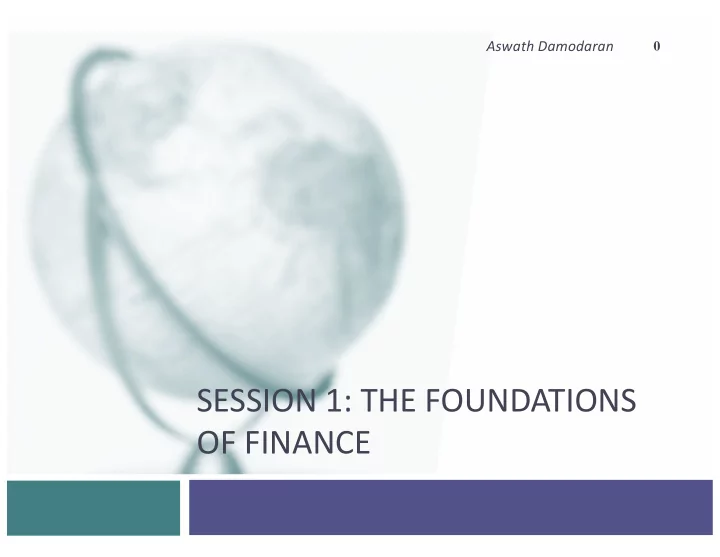

Aswath Damodaran 0 SESSION 1: THE FOUNDATIONS OF FINANCE
It’s always about money… ¨ The old saying that it is always about the money sounds crass but in business, it is always true. ¨ No matter what aspect of business or investing you are talking about or in, no matter how fuzzy or qualitative, the ultimate effect is in earnings and cash flows. ¨ Finance is therefore not just another function of business, but is the measuring rod for all of business. 1
The Building Blocks 1. The Concept and Structure of Business Forward looking, not backward looking 2. The Measurement and Importance of Cash Flows Earnings are only a stopping point, not the destination 3. The Definition and Measurement of Risk Risk is neither good nor bad. It is part of business. 4. The Time Value of Money A dollar today is worth more than a dollar in the future 5. The Basics of Valuation The value of an asset is the present value of its cash flows 6. Trading Fundamentals There are no free lunches and the world is full of frictions 2
1. The Concept of a Business § Understanding how a business is structured in finance is central to recognizing the challenges you will face in running and valuing a business. § On the asset side: While in finance, like accounting, we break down a business into its assets, the focus is always on the future. Thus, the value of assets in finance is not in what you invested in them but what they will generate as earnings/cash flows for you in the future. § On the financing side, finance keeps it simple. There are only two ways to fund a business: debt and equity. 3
2. The Importance of Cash Flows ¨ If there is one defining feature in finance, it is its dependence on cash flows, rather than more widely used accounting measures of performance (like earnings). ¨ Earnings vs Cash Flows: Understanding how to measure cash flows and why these cash flows may be different from earnings is the first step towards financial literacy. ¨ Forms of Cash Flows: Recognizing the different forms that cash flows can take, from contractually set cash flows to residual cash flows to contingent claim cash flows is the next step towards valuing them. 4
3. The Definition and Measurement of Risk ¨ The notion that human beings are risk averse is central to how we value cash flows in finance, but that adjustment for risk requires three steps: ¤ A definition of risk that reflects its two-sided nature, i.e., that it yields both positive and negative outcomes. ¤ A judgment on whose perspective on risk matters when it comes to value ¤ A conversion of this risk definition into a risk measure that can then be used to adjust value. ¨ The history of risk measurement over the last few centuries strongly correlates with the development of finance as a discipline. 5
4. The Time Value of Money ¨ The question: A dollar today is worth more than a dollar a year from now. That is the nostrum with every finance class begins, but why? ¨ The intuition behind the time value of money is both simple and all-encompassing. It comes from the preference for current consumption, the concerns about pricing power and risk in the cash flows. ¨ The mechanics of computing present value are also simple but also ubiquitous. 6
5. Valuation o Valuation is simple. It is just an extension of the present value concept, where the value of an asset or business is the present value of the expected cash flows on that asset or business. o That said, the mechanics of valuation are different for different types of cash flows: o For contractually fixed cash flows, you discount promised cash flows at a discount rate, adjusted for default risk. o For residual cash flows, you discount expected cash flows at a discount rate that reflects the risk that investors perceive in these cash flows. o For contingent cash flows, you value the asset using an option pricing model. 7
6. Trading and Frictions • Why they matter: Financial markets are the lubricants that allow businesses to raise capital and fund investments. They are also the laboratories where we come up with data that we use in measuring risk and value. • Investors in these markets are in them to make returns on their investments. Not surprisingly, they would like to invest little or nothing, take no risk and make money. That is the essence of arbitrage. • While there are many who claim to find arbitrage opportunities in markets, there are two frictions that get in the way. • The first is that trading has costs • The second is that the government collects taxes 8
Recommend
More recommend